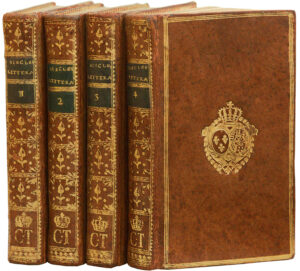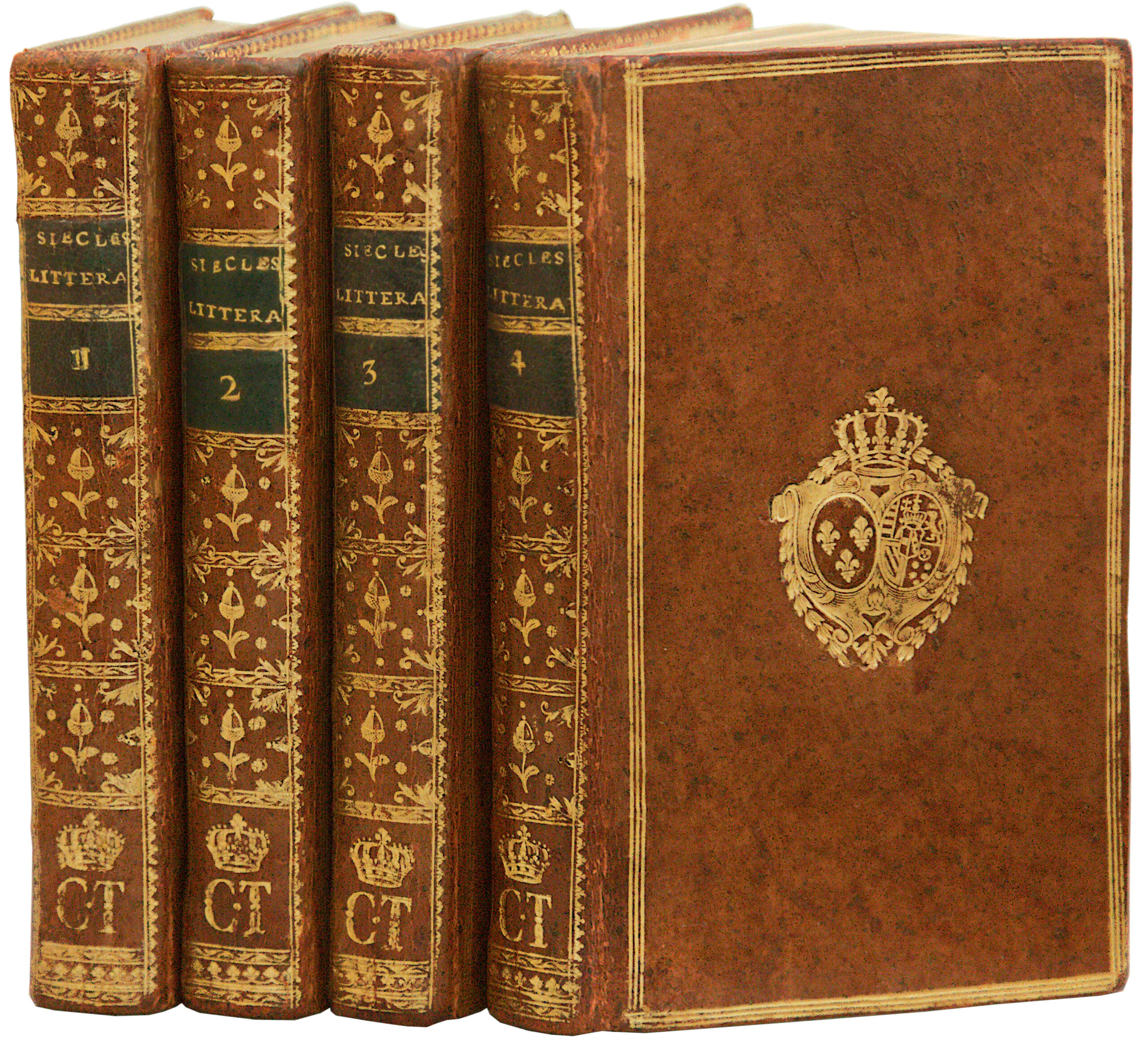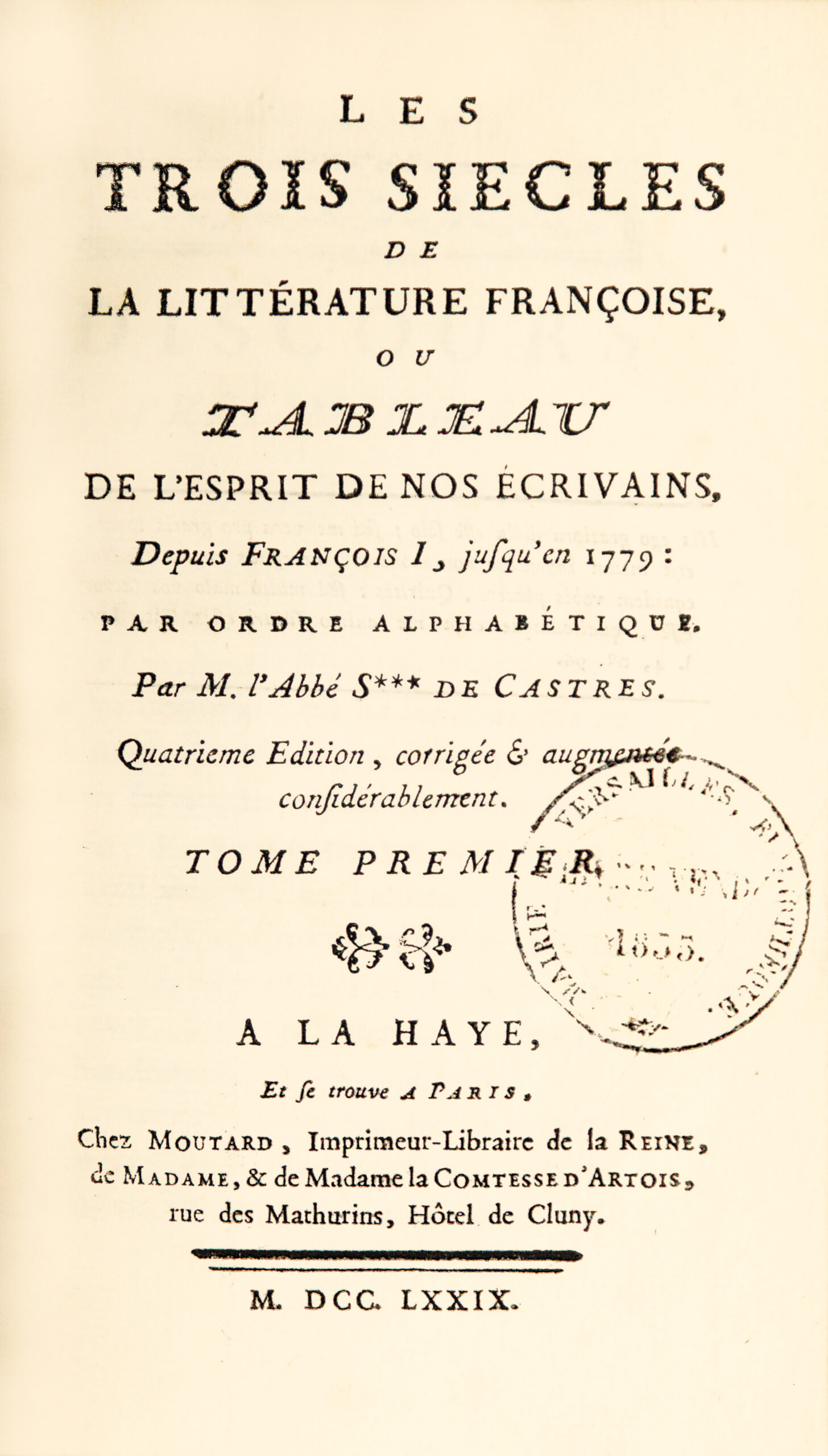La Haye et Paris, chez Moutard, 1779.
4 volumes 12mo of : I/ cvii pp. (small hole p. xxi), 387 pp. ; II/ (1) l., 488 pp. ; III/ (1) l., 454 pp. ; IV/ (1) l., 443 pp., small tear in the white margin of the last p.
Bound in full mottled calf, the covers stamped with the coat of arms of Queen Marie-Antoinette under the royal crown in a triple frame with small gilt tool, flat spines decorated with foliage and acorns, green morocco title-pieces, titles in gold lettering, bearing the gold mark “C.T.” (Château Trianon) under the royal crown for the Petit Trianon, mottled edges. Contemporary royal bindings.
167 x 99 mm.
Partly original edition of “Three Centuries of French Literature” by Abbe Sabatier de Castres.
Sabatier often harshly attacked Voltaire in Les Trois siècles. Voltaire, of course, reacted strongly. He called him l’abbé Sabotier (M, vol. X, p. 197; vol. XXIX, p. 39). In his correspondence, he cannot find words harsh enough against “the vilest of scoundrels” (D19090). In the Dedicatory Epistle to the Lois de Minos, Sabatier is considered to be “the most wretched and lowly writer” imaginable (M, vol. VII, p. 172). Sabatier was not only opposed to Voltaire, but to the entire Enlightenment movement. It was a “tyrannical and inconsistent philosophy […] [that] suffocates or corrupts the germ of talent” (T.S., vol. I, pp. 1-2). In short, the new literature was characterized by “an imposing tone, a dogmatic style, mannered jargon, sententious phrases, enthusiastic feelings, the repetition of those parasitic words humanity, virtue, reason, tolerance, happiness, philosophical spirit, love of humankind and a thousand other terms that have become the safeguard of ineptitudes” (Corr. litt., p. 241). In Les Trois siècles, Condorcet, Diderot, Duclos and Marmontel are treated without mercy; only Condillac and Rousseau find favour in Sabatier’s eyes, Rousseau in particular: “he cannot be disputed for the glory of eloquence and genius and for being the most masculine, profound and sublime writer of this century” (vol. IV, p. 139).
Les Trois siècles de la littérature française led to his fame, but also made him many enemies. Sabatier’s authorship of Trois siècles was disputed.
Abbé Martin, vicar of the parish of Saint-André-des-Arts, to whom Sabatier “went every morning to study and learn” (M.S., 7 August 1774, t. VII, p. 225), was presented by J. Lenoir-Duparc in his Observations sur les Trois siècles de la littérature française (1774) as the true author. Abbé Beaudoin, grand maître of Cardinal Lemoine’s college, supported this interpretation. The case dragged on and began to be heard at the Châtelet in May 1780, even though Abbé Martin had died in the meantime.
In the end, a ruling on 4 July 1780 settled the matter: Sabatier was to acknowledge in writing that Abbé Beaudoin was “a man of probity and honour“; each party was to waive its claims for damages; and Sabatier was to pay the costs of the ruling. In his Mémoires sur la littérature, Palissot complained of having been plagiarized by Sabatier. The Memoirs, he said, had “almost always been pillaged and dishonored in the slightly reasonable things he [Sabatier] said” (Palissot, t. V, p. 309). Sabatier defends himself in his unpublished Articles inédits de la 7ème édition des Trois siècles (pp. 14-16). According to the M.S., it was thanks to the “reputation” that his Trois siècles had earned him in “the opposing party” that Sabatier was appointed tutor to the children of Vergennes, Minister of Foreign Affairs, in January 1776.
A precious and beautiful copy, specially bound for the personal library of queen Marie-Antoinette at the chateau de Trianon.
Marie-Antoinette encouraged the arts, by supporting Gluck against the cabal and routine, and literature, by protecting Chamfort and Delille, and she showed herself, in the long agony of the bad days, to be the worthy daughter of the great Marie-Therese.
Her library was one of the most extensive of the time, and if the plays, novels and, among them, the little fashionable books, which the party spirit has sought, today, to make a kind of scandal, although they were then in the hands of the most honest and virtuous women, it would be unfair to forget that the masterpieces of the human mind take pride of place here, with Pascal, Bossuet, Fenelon, Bourdaloue, Massillon, Boileau, Jean-Baptiste Rousseau, Corneille, Molière, Racine, Regnard, Voltaire, and so many others, whose names can be found in the catalogue.
Most of the volumes that lined the cupboards of the Petit Trianon remained in Versailles; some were added to the rich contingent of the French National Library, others were transported to Périgueux and Bourges when the central department schools were created in 1795, and then to public libraries. They are modestly bound in porphyry calf, grained with black dots on a dark red background that sometimes turns dark purple. The covers, surrounded by a triple fillet, bear the queen’s coat of arms in the centre; the spine is decorated with a few fleurons and, at the bottom, the crowned initials C.T. (Château de Trianon) are gilt-stamped. The blond or pale fawn edges are dotted with red. There are also a large number of volumes in half-binding, with the spine and corners in fawn calf and the coat of arms on the paper.
Baron Pichon has given us the names of the workmen who carried out this work. The calf bindings come from the workshops of the bookbinder Fournier.
This copy is listed under n°554 in the catalogue of Queen Marie-Antoinette’s library at the Petit Trianon (P. Lacroix, 1863).


